Forensics: Super Famicom component-mod
The original version of this piece appeared in Thresholds 2, a special issue on the work of German media theorist Siegfried Zielinski.
What follows are notes on a forensic examination of one console from the Residual Media Depot collection: a Nintendo Super Famicom (SHVC-001 – Japanese model) that has been modified with the addition of ports for composite video, S-video and component video, while leaving the functionality of Nintendo’s “multi out” connector intact.
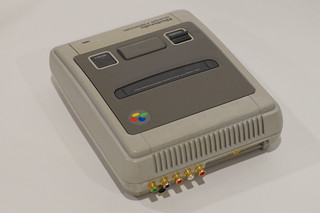 The Super Famicom first appeared in Japan in 1990, then in North America in 1991 as the Super Nintendo Entertainment System (SNES), with a different case design. Dominic Arsenault’s recently published Super Power, Spoony Bards, and Silverware. (MIT Press, 2017) provides a comprehensive history of the console in all of its various orthodox forms, but my questions begin where Arsenault’s book ends.
The Super Famicom first appeared in Japan in 1990, then in North America in 1991 as the Super Nintendo Entertainment System (SNES), with a different case design. Dominic Arsenault’s recently published Super Power, Spoony Bards, and Silverware. (MIT Press, 2017) provides a comprehensive history of the console in all of its various orthodox forms, but my questions begin where Arsenault’s book ends.
I want to understand this console’s residual afterlife, because 27 years after its first appearance, it has still not vanished. In fact, with the recent runaway success of the Super Famicom Classic and the Super NES Classic Edition emulators, the original machine is more visible to the general public than it has been in decades. There are overlapping global economies based around bricolage, micro-manufacturing, collecting, reuse and nostalgic recommodification to explore, all of which unfold after the console’s life-cycle as a consumer commodity. As a starting point, I want to know what the modifications this console has received can convey about how objects like it are changing culture even as it is itself being transfigured.
The component-modded Super Famicom console came from an ebay seller named “Retrotechrewind” (228 blue stars, 202 positive ratings as of this writing). The Paypal receipt from the purchase identifies him as Lucas Henkel. Here’s the full text of the description in the ebay ad he wrote for the console:
For sale is a Super Famicom system. Console has been cleaned, modded, and refurbished. All capacitors have been replaced, new power regulator, new power LED etc. Console is in overall good shape, with some minor discoloration, although not as bad as many nowadays.
Console has Component, S-Video, Composite video, and Stereo Audio gold-plated jacks installed on the back of the console. No need for special proprietary cables! Component is 240p, so make sure your TV will accept this before buying!
New power supply and one 3rd party controller included. NO GAMES included, shown working with real games and Flash cart for demo purposes only.
FAST shipping via priority mail. Any questions, please ask!
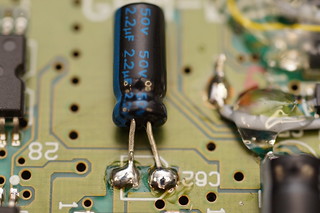 Why all of this modification? This console is probably 27 years old, so it has been cleaned and “recapped.” That is, the capacitors on the motherboard have been replaced with newer equivalents. The electrolytes inside old capacitors can leak, resulting in an increased flow of electrical current, inefficient power dissipation and damage to the circuitry.
Why all of this modification? This console is probably 27 years old, so it has been cleaned and “recapped.” That is, the capacitors on the motherboard have been replaced with newer equivalents. The electrolytes inside old capacitors can leak, resulting in an increased flow of electrical current, inefficient power dissipation and damage to the circuitry.
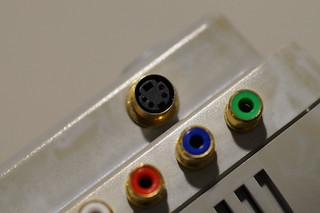 The addition of the ports is another matter. With the correct cables, the multi-out port on a Super Famicom or SNES can already output composite video, S-video and RGB. The latter is the best quality signal, but it is usually delivered through a SCART. This is the “expensive cable” in the language of the ad; there are effectively two reliable sources for these in the world (one in the USA, and one in the UK), so a single cable can cost as much as $80 CAD after currency conversion, taxes, and import charges.
The addition of the ports is another matter. With the correct cables, the multi-out port on a Super Famicom or SNES can already output composite video, S-video and RGB. The latter is the best quality signal, but it is usually delivered through a SCART. This is the “expensive cable” in the language of the ad; there are effectively two reliable sources for these in the world (one in the USA, and one in the UK), so a single cable can cost as much as $80 CAD after currency conversion, taxes, and import charges.
Virtually no TVs or monitors available in North America have ever featured a SCART port. Modding hobbyists use video interfaces (like the Extron 201 Rxi) or upscalers and video processors (like the OSSC and the XRGB-mini Framemeister) to connect SCARTs from RGB-capable consoles to professional video CRT monitors or contemporary flatscreen HDTVs, respectively. But this is an arcane process, requiring imported, difficult-to-configure equipment and hundreds of dollars of financial outlay.
A component signal, on the other hand, can be nearly as good as an RGB signal (though the video processors and upscalers in TVs don’t do as nice a job with the 240p signal from an old console as a Framemeister or OSSC will). Generic component cables are cheap and available around the world, and many TVs and monitors (digital and analog) still have component ports. Further, there is a long-standing contention in console-modding circles that the Picture Processing Unit (PPU) in early Super Famicom consoles like this one produces a blurry RGB signal, and that the component signal that can be extracted from it, with some work, might be better.
 However, it’s also an article of faith that later Super Famicom revisions, the 1CHIP-01 and 1CHIP-02 from after 1995 (called “1CHIP” units because they used a single combined video chip instead of two separate ones), produce the best picture that the device is capable of, often without modification (though the 1CHIP-03 requires a handful of small components that cost about a dollar to be restored to the board to enable synchronization”; the Depot has one of these too).
However, it’s also an article of faith that later Super Famicom revisions, the 1CHIP-01 and 1CHIP-02 from after 1995 (called “1CHIP” units because they used a single combined video chip instead of two separate ones), produce the best picture that the device is capable of, often without modification (though the 1CHIP-03 requires a handful of small components that cost about a dollar to be restored to the board to enable synchronization”; the Depot has one of these too).
In all cases, these optimal signals will be RGB. In North America, the Super Famicom was always and still is relatively rare, as they use differently-shaped cartridges than an SNES, and require a substitute power adapter to function (many contributors to online discussion suggest that an original Sega Genesis model 1 adapter is the best option). So why not just buy a 1CHIP or a Super Famicom Jr.?
I think the answer is that a console like this one offers an occasion for the deployment of technique. Such an occasion is governed by a discourse that produces subjects capable of employing those techniques, as well as discussing and debating their merits … and the relative merits of other practices, objects and participants in the discourse.
As a technique, modding involves several long chains of interlinked operations, including, but not limited to: bypassing Nintendo’s security screws; console disassembly; surface cleaning techniques; circuit design; part sourcing; obtaining (and sometimes translating) schematics, specifications and circuit diagrams; soldering and desoldering; wiring; drilling holes through brittle plastic casing; and documentation of the process in various media.
Circulating the documentation of the modding process involves other chains of operations: photography and videography; video and audio editing; the niceties of various social media networks, including tagging, linking, search engine optimization and cross-promotion; threaded conversation on discussion forums; the argot and etiquette of interacting with the members of particular online communities, and so on.
Interpretive technique involves a third set of operations, particularly for non-experts like me. Until this year, I hadn’t read or written a circuit diagram since Grade 8 shop class in 1980, but found it necessary to muddle through the process in order to figure out what was going on inside this console. Finding a diagram similar to the physical setup in this console helped a great deal (so online search skills were important), but then I had to account for the differences between the diagram I had found and the specific configuration of what was sitting on the bench in front of me. This involved other operations, like reading the colour-coded bands on resistors to determine their value and function (thankfully, this is now managed prosthetically via interactive web forms instead of memorization, the way we did it in Junior High School). Digital macro photography was important in terms of documenting the process and identifying parts, especially given my failing eyesight, but once again, I hadn’t picked up an SLR since they used film. And the blackboard wall in the Media History Research Centre once again paid for itself by allowing for mistakes and corrections in this process.
 With the exception of the ports themselves and the new capacitors, most of the circuitry that has been added to this Super Famicom is contained on a single tiny piece of perforated prototyping board (“perfboard”) that has been hot-glued to the front right inside corner of the case.
With the exception of the ports themselves and the new capacitors, most of the circuitry that has been added to this Super Famicom is contained on a single tiny piece of perforated prototyping board (“perfboard”) that has been hot-glued to the front right inside corner of the case.
All of the components on the board have to do with the isolation and clarification of signals for composite video output, so that’s where I’m going to concentrate my attention for the rest of this brief essay.
 The blackboard diagram I produced explains how the new circuit works in relation to the video processing chip and the component video connectors that have been added to the case.
The blackboard diagram I produced explains how the new circuit works in relation to the video processing chip and the component video connectors that have been added to the case.
There are 3 channels in composite video, often represented as “Y,” “Pb,” and “Pr.” Y, which contains information about luma (brightness) plus synchronization information, is pulled directly from the console’s multi out plug, and connects directly to the green port. The Pb channel is technically not blue, but the difference between blue and luma. Likewise, Pr is the difference between red and luma. (In component video, the value of green in the video image is derived mathematically from the other signals.)
 Both the Pb and Pr channels have been tapped from the BA6594AF processing chip — Pr from pin 1, and Pb from pin 24. The hot-melt glue that covers this chip in this photo was removed with an alcohol-impregnated cotton swab after the initial examination, but I wanted a photographic record of the state in which the Depot received it.
Both the Pb and Pr channels have been tapped from the BA6594AF processing chip — Pr from pin 1, and Pb from pin 24. The hot-melt glue that covers this chip in this photo was removed with an alcohol-impregnated cotton swab after the initial examination, but I wanted a photographic record of the state in which the Depot received it.
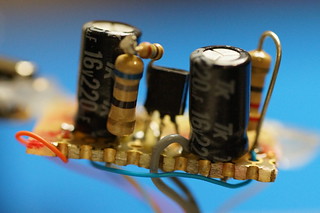 The Pb channel passes through a 220µF capacitor (the large black cylinder in the foreground of the image).
The Pb channel passes through a 220µF capacitor (the large black cylinder in the foreground of the image).
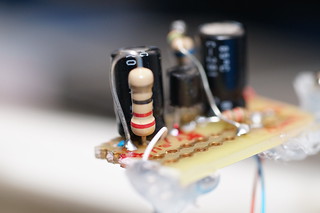 The Pb then passes through a 22 ohm resistor, which terminates the 3.35 volts coming down the line, and then connects to the “blue” port.
The Pb then passes through a 22 ohm resistor, which terminates the 3.35 volts coming down the line, and then connects to the “blue” port.
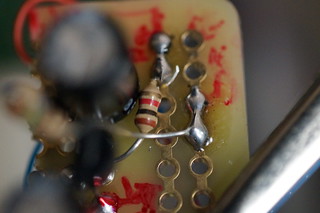 Pr passes through a 1K ohm resistor that protects the processing chip against shorts from the transistor that follows. Note also the annotations on the board in red permanent marker, which provide a trace of the planning and design process that preceded assembly on the perfboard.
Pr passes through a 1K ohm resistor that protects the processing chip against shorts from the transistor that follows. Note also the annotations on the board in red permanent marker, which provide a trace of the planning and design process that preceded assembly on the perfboard.
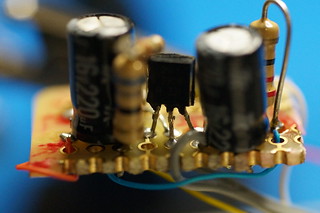 The signal then enters a 2N3904H3 transistor (centre, in focus)
The signal then enters a 2N3904H3 transistor (centre, in focus)
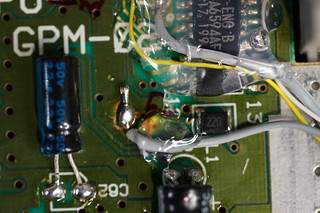 … along with +5V pulled from the board (the solder lump left of the red “5” written on the board) …
… along with +5V pulled from the board (the solder lump left of the red “5” written on the board) …
 … then goes to a split where a 25 ohm and a 68 ohm resistor chained together (by the left capacitor) go to ground on one side.
… then goes to a split where a 25 ohm and a 68 ohm resistor chained together (by the left capacitor) go to ground on one side.
Again, this differs from other diagrams I have seen for similar circuits, which utilize a single 80 ohm resistor. I don’t have the expertise to determine whether more resistance was necessary or the modder simply didn’t have an additional 80 ohm resistor on hand. On the other branch of the split, the signal passes a through a 220µF capacitor to the “red” port.
This is the how but not the why of this particular mod — and arguably of modding in general. The answer to the why is that the use of technique is also an occasion for the production and circulation of discourse about that technique, which is the precondition for community and culture. The fact that it’s possible to find discussions and documentation about several versions of this mod, which in turn points to earlier documents by earlier modders (in many cases with dead links), but not to this exact configuration, indicates that console modding is a living community that continues to add members and develop existing practices.
Techniques can also be the source of conflict and controversy, which once again demonstrates that the community is large enough to support debate. Such quibbles are rarely about whether the enterprise of modding itself should take place, but usually have more to do with its finer points: the quality of soldering; the weight and coloration of wires; the source and type of electronic components and so on.
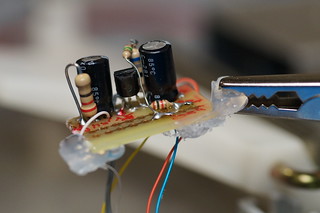 The major point of disagreement I encountered while examining this console was the use of hot-melt glue over soldering as a material support and insulation for soldered joints. In this console, there was a substantial amount of glue over the perf board, and there remains a huge amount of it over the entire video processing chip.
The major point of disagreement I encountered while examining this console was the use of hot-melt glue over soldering as a material support and insulation for soldered joints. In this console, there was a substantial amount of glue over the perf board, and there remains a huge amount of it over the entire video processing chip.
Casual online searching reveals decidedly split opinions over the merits of this practice. Most interesting to me is that this can actually become the occasion for further deployment of another technique: the use of alcohol swabs to remove the glue from PC boards with no cutting or application of force. There are entire YouTube videos that deal solely with this issue.
Carolyn Marvin’s When Old Technologies Were New, and account of the discursive communities that sprang up in the late nineteenth century around “electrical experts” working with the telegraph, the telephone and other electrical communication devices is as germane to the discussion of online modding communities today as it was about its original subject. Sometimes the use of technique results in production of new forms of knowledge (variations, exceptions, improvements, refutations, etc.), but once they begin to circulate, the records of the performance of technique itself serve as a mechanism for the ongoing production of certain kinds of subjects within the community — what Marvin refers to as “electrical experts.”
Consider once again the case of retro_tech_rewind. An Instagram account and an account on neo-geo.com with the same alias identify him as a professional electronics engineer. He also appears as a regular on the Central Pennsylvania Reviews YouTube channel. There’s a lot of communicative work going on in terms of the process of modding here, of course, but it also establishes a reputation for the modder within the community. In addition to retro-tech_rewind’s self-identification as a professional electronic engineer, the epithets that a third-party Instagram-viewing site like pictaramclub attach to his Instagram posts in order to attract clicks are equally interesting, and indicative of the value that readers place on expertise: “The masterful @retro_tech_rewind” and “Lucas the tech wizard aka @retro_tech_rewind”. On the other extreme, people in the Arcade Projects and Neo-Geo forums take a dimmer view of Henkel’s modding abilities. When even finding the conversation can be difficult, a basic degree of expertise is the price of admission. Communication to a general audience about the community and its techniques apparently requires a higher attribution of skill.
All of this began for me several years ago as what I thought of at the time as a simple problem: how to plug a first-generation Xbox into a classroom’s teaching console. I am a tenured professor and an established media historian, but in the context of the console-modding community, I’m decidedly an amateur. So far, writing about modified game consoles in the most basic of ways has required securing funding, collecting the machines (learning which ones were worth having, seeking them out, then managing university purchasing protocols and regulations), negotiating for a place to store them, developing some familiarity with material media collections theory and practice, and now, learning about signal processing, basic electronics, and macro photography, among other things.
Siegfried Zielinski’s call for a philology of nonperfect precise things is an occasion for the practice of a form of media-historical scholarship that combines the best of political economy, cultural studies, theories of the materialities of communication, circulation theory, media archaeology, media forensics, and the study of cultural technique. In the face of ubiquitous imperfection, there’s nothing to exclude and a world to describe … with the understanding that our descriptions, too, will be flawed, and will in turn require further revision and description.